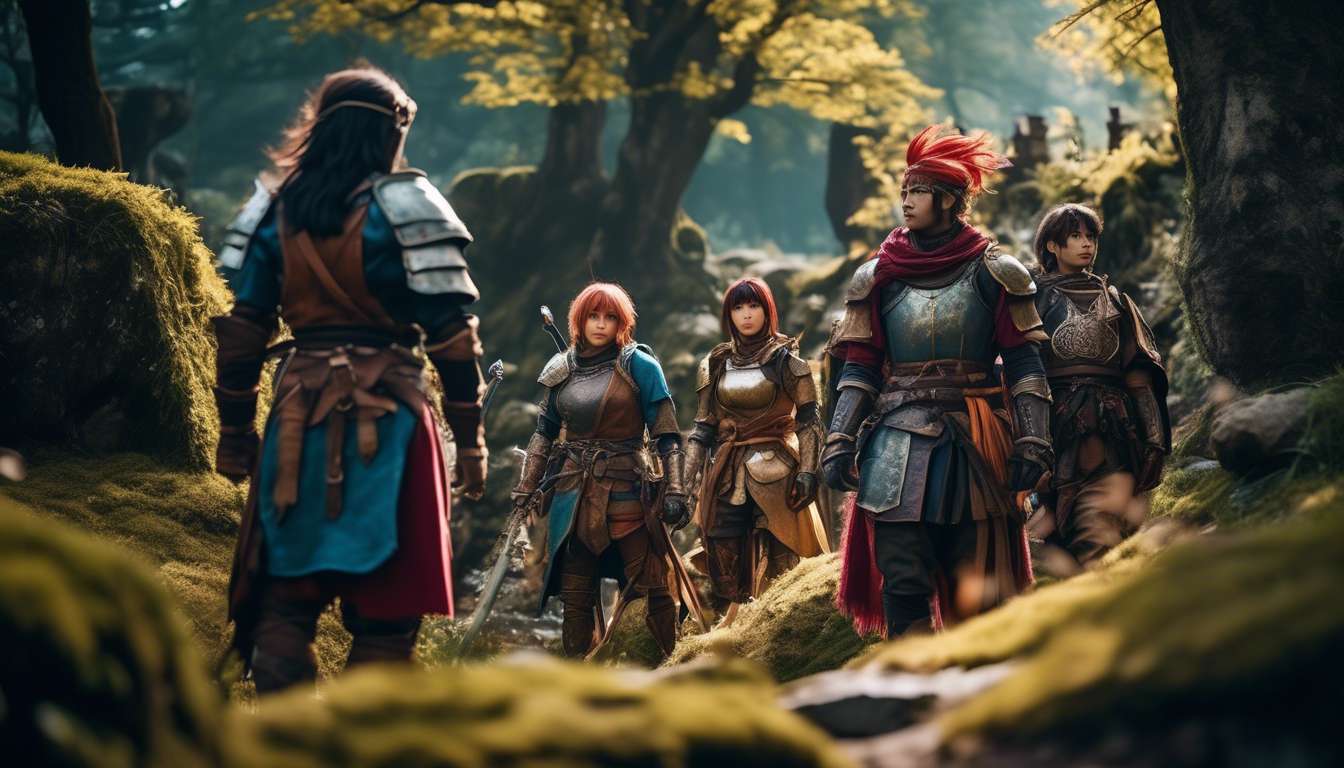When we first delved into the world of role-playing games, we were captivated by the diverse universes and compelling stories they offered. Yet, as we explored further, we noticed a distinct divide between Japanese role-playing games (JRPGs) and their Western counterparts, RPGs. This discovery piqued our curiosity, prompting us to delve deeper into what sets these two genres apart.
Whether it’s the narrative style, character development, or gameplay mechanics, each brings its own unique flavor to the table. In this article, we aim to explore the top five differences between JRPGs and RPGs, shedding light on the elements that define these beloved genres.
By examining these differences, we hope to provide fellow gamers with a clearer understanding and appreciation for the intricate designs and cultural influences that make each genre special. Let’s embark on this journey together, celebrating the diversity within the gaming world.
Narrative Style
JRPGs often feature linear narratives with predefined characters. The storytelling style is like a familiar embrace, guiding us through a carefully crafted tale enriched with cultural influences from Japanese mythology and art. Each chapter is meticulously designed to evoke emotions and connect us closely to the journey.
RPGs, in contrast, offer more player-driven stories with customizable protagonists. Here, we become the architects of our own stories, shaping characters and paths that resonate with our individual experiences. The gameplay mechanics allow for greater freedom and exploration, and the cultural influences are diverse, often reflecting a broader range of mythologies and settings.
Yet, both genres share a common goal:
- To immerse us in worlds where we belong
- Whether through the comfort of JRPGs’ linear tales
- Or the expansive narratives of RPGs.
As fans of these genres, we find ourselves drawn to the unique storytelling styles each presents.
Character Development
Character Development in JRPGs:
Character development in JRPGs often centers around deep, predefined arcs. This narrative style is a hallmark of JRPGs, where characters typically start with specific traits and gradually evolve. Their growth and transformation throughout the story are influenced by rich storytelling and cultural influences from Japan.
We find ourselves emotionally invested as we accompany them on their journey, feeling a sense of camaraderie and shared purpose.
Character Development in Western RPGs:
In Western RPGs, character development takes a different path.
- We often have more control over a character’s evolution.
- We can shape their personalities and destinies through choices and gameplay mechanics.
This flexibility allows us to craft a unique narrative style that reflects our own preferences and decisions, fostering a different kind of connection.
Comparative Insights:
Both approaches to character development offer us a sense of belonging:
- Through the shared experience of a predetermined journey in JRPGs
- Through the personal touch of individual choices in Western RPGs
Each style speaks to our desire to connect and empathize with the stories we explore, influenced by diverse cultural influences.
Gameplay Mechanics
We often experience JRPGs and Western RPGs through their distinct gameplay mechanics, each offering unique challenges and rewards.
JRPGs feature:
- Turn-based combat systems that allow us to strategize and plan our moves, creating a more calculated experience.
- A linear narrative style, guiding us through an epic storyline that unfolds like a gripping novel.
- Cultural influences that emphasize teamwork and collective journeys, making us feel part of something larger.
In contrast, Western RPGs often present:
- Real-time combat, emphasizing player agency and immediate decision-making.
- The freedom to explore expansive worlds, shaped by our choices.
- A narrative style that adapts to our decisions.
- Cultural influences that highlight individualism and personal growth, inviting us to carve our own path.
Both styles captivate us by offering gameplay mechanics that resonate with our desire for belonging, whether through collective quests or personal adventures.
Visual Aesthetics
Both JRPGs and Western RPGs captivate us with their distinct visual aesthetics, reflecting their unique cultural origins and artistic inspirations.
JRPGs often embrace bold, vibrant colors and stylized character designs, influenced by anime and manga. This artistic choice enhances the narrative style, creating worlds that feel fantastical and immersive. We often find ourselves drawn to these games, where the visuals complement intricate storylines and emotionally resonant characters.
Western RPGs, on the other hand, tend to favor realism and detailed environments, drawing inspiration from Western mythology and history. The visual aesthetics here support a narrative style that often emphasizes choice and consequence, intertwining deeply with gameplay mechanics. These worlds feel familiar yet expansive, inviting us to explore landscapes steeped in cultural influences that resonate with our own histories.
Both styles offer us a sense of belonging, connecting us to diverse storytelling traditions and artistic expressions. Whether we lean towards the colorful worlds of JRPGs or the grounded realism of Western RPGs, there’s something for everyone.
Combat Systems
When we dive into combat systems, JRPGs often captivate us with turn-based mechanics, while Western RPGs typically immerse us in real-time action. This difference in gameplay mechanics reflects the distinct narrative styles and cultural influences that shape each genre.
In JRPGs, the turn-based system allows us to:
- Strategize and engage deeply with the storyline.
- Mirror a more methodical and introspective narrative style.
- Become part of a shared journey, where every decision counts and camaraderie thrives.
On the other hand, Western RPGs invite us into a fast-paced world where real-time combat keeps us on our toes. Here, the narrative style is often more open-ended, allowing us to:
- Forge our own paths and decisions in a vivid, dynamic setting.
- Experience cultural influences that emphasize individuality and action.
- Foster a sense of empowerment and immediacy.
Whether we relish the strategic depth of JRPGs or the adrenaline rush of Western RPGs, both styles offer unique, enriching experiences.
World Building
In world building, both JRPGs and Western RPGs create immersive environments that reflect their distinct cultural roots and storytelling traditions.
JRPGs draw us into vibrant, fantastical realms where the narrative style often intertwines with gameplay mechanics to form a cohesive experience. These worlds are:
- Rich in lore
- Feature intricate storylines
- Unfold in a linear fashion
- Guide us through emotional journeys and character-driven plots
In contrast, Western RPGs emphasize open-world exploration and player agency. The narrative style in these games allows for more freedom, encouraging us to shape our own stories within vast, dynamic landscapes. The gameplay mechanics support this autonomy by offering choices that affect the world and its inhabitants. As we navigate these realms, we experience:
- A sense of ownership and belonging
- The knowledge that our decisions leave a lasting impact
Both genres, shaped by their cultural influences, invite us into worlds where we can lose ourselves, exploring diverse narratives and mechanics that resonate with our quest for connection.
Cultural Influences
Cultural Roots in RPGs
Cultural roots deeply shape the design and storytelling of both JRPGs and Western RPGs, reflecting distinct philosophies and societal values.
JRPGs:
- Often draw from Japanese mythology and aesthetics.
- Weave intricate tales with a narrative style that emphasizes character development and emotional depth.
- Stem from cultural influences that prioritize community and harmony.
Western RPGs:
- Frequently explore themes of individualism and freedom.
- Driven by a narrative style that’s more open-ended and player-driven.
- Mirror Western cultural values of exploration and self-discovery.
Gameplay Mechanics
JRPGs:
- Often employ turn-based systems.
- Reflect a strategic, methodical approach akin to traditional Japanese games like shogi or go.
Western RPGs:
- Tend to favor real-time combat.
- Offer dynamic gameplay mechanics that align with fast-paced Western entertainment.
Conclusion
By appreciating these cultural influences, we connect more deeply with the games we play, understanding the unique perspectives they present and the shared experiences they offer.
Player Engagement
Player engagement in both JRPGs and Western RPGs hinges on how effectively they immerse us in their worlds and stories.
JRPGs often captivate us with their intricate Narrative Styles.
- Characters and plotlines are deeply intertwined.
- Cultural influences offer a unique lens for exploring themes of friendship, honor, and self-discovery.
Western RPGs focus heavily on Gameplay Mechanics.
- Emphasize player choice and freedom, allowing us to shape the story and world.
- The narrative is usually more open-ended, providing a personal stake in the adventure.
- Cultural influences highlight themes of individuality and exploration, resonating with our desire to carve our own path.
In both genres, player engagement thrives on the seamless blend of narrative and mechanics, inviting us to belong to these fantastical realms.
What are some popular JRPG and RPG titles that exemplify the key differences between the two genres?
Key Differences Between JRPGs and RPGs
JRPGs (Japanese Role-Playing Games):
- Titles such as "Final Fantasy" and "Dragon Quest" are prime examples.
- Known for their emphasis on storytelling and unique art styles.
- Often feature linear narratives and well-developed characters.
RPGs (Role-Playing Games):
- Titles like "The Elder Scrolls" and "The Witcher" are representative.
- Focus more on open-world exploration and player choice.
- Offer vast, immersive worlds with a high degree of freedom and decision-making.
These games highlight the diverse experiences each genre offers, from the narrative-driven journey in JRPGs to the open-ended exploration found in RPGs.
How do the music and soundtracks typically differ between JRPGs and RPGs?
In JRPGs, music and soundtracks play a crucial role in enhancing the gaming experience. They often feature:
- Catchy melodies
- Orchestral arrangements
- Memorable themes
These elements are designed to immerse players in the game world and evoke specific emotions related to the story and character development.
On the other hand, RPGs may offer a more diverse musical experience. Their soundscapes can incorporate different genres of music to complement:
- The gameplay experience
- The setting
This variety in music helps to create a rich and engaging atmosphere tailored to the unique aspects of each game.
Are there any significant differences in the target audience for JRPGs versus RPGs?
When discussing target audiences for JRPGs and RPGs, there are indeed significant differences:
JRPGs often cater to a younger demographic. They focus on:
- Engaging storylines
- Colorful characters
These elements resonate with an audience influenced by anime and manga.
Traditional RPGs, on the other hand, tend to have a broader appeal. They attract gamers of all ages who appreciate:
- Diverse gameplay mechanics
- Immersive world-building
These distinctions shape the unique experiences each genre provides.
Conclusion
In conclusion, when comparing JRPGs to RPGs, it’s clear that the differences lie in several key areas:
- Narrative Style
- Character Development
- Gameplay Mechanics
- Visual Aesthetics
- Combat Systems
- World Building
- Cultural Influences
- Player Engagement
Understanding these distinctions can enhance your appreciation for both genres and help you choose games that align with your preferences.
So, next time you’re looking for a new gaming experience, consider these factors to find the perfect match for your gaming style.

